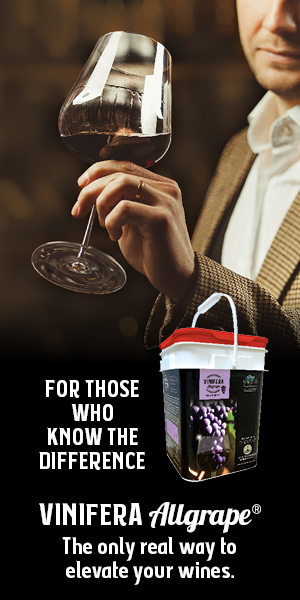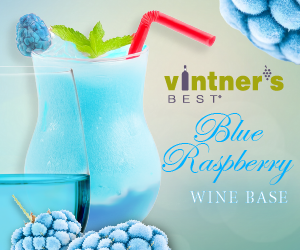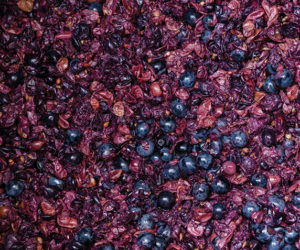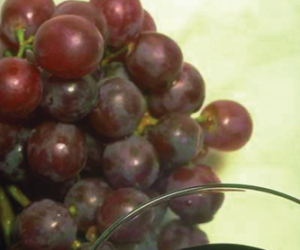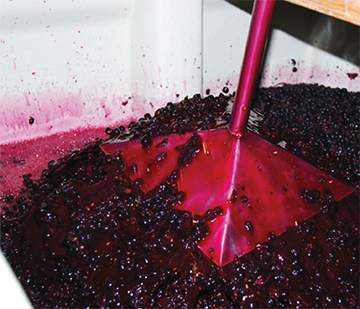 As a winemaking educator I often get asked the question “What is the most important aspect of red winemaking?” The truth is that all winemaking decisions really depend on what you have to work with for fruit, and what your vision is for the finished wine. But if I were forced to choose at least one stage, it would be skin contact. Skin contact, in synergy with yeast choice and fermentation temperature, influences a finished wine probably more than any other part of the winemaking process once the grapes are harvested. If you employ too little skin contact the wines can lack color or body; too much contact and you wind up with wines that are too bitter or astringent.
As a winemaking educator I often get asked the question “What is the most important aspect of red winemaking?” The truth is that all winemaking decisions really depend on what you have to work with for fruit, and what your vision is for the finished wine. But if I were forced to choose at least one stage, it would be skin contact. Skin contact, in synergy with yeast choice and fermentation temperature, influences a finished wine probably more than any other part of the winemaking process once the grapes are harvested. If you employ too little skin contact the wines can lack color or body; too much contact and you wind up with wines that are too bitter or astringent.
To make the most informed decisions for skin contact in your wines, you must have a good understanding of what is happening in your grapes and the quality of the fruit when they come in from harvest. In this article, we will explore how grape skins can both positively and negatively affect your wines, and how to make educated decisions about skin contact. In reality, pure and simple skin contact has been the basis for winemaking for centuries. There are many proposed “better” mechanisms for winemaking out there, but I will quietly defer the discussion about enzymes and color improving winemaking to another article.
The Basics of the Berry
To understand skin contact, let’s first explore the fruit itself. The grape berry is a reservoir of color, tannins, and aroma compounds, and the winemaking process coaxes them out of the berry and into solution. A berry consists of three main components: The exocarp, mesocarp, and the endocarp. The endocarp consists primarily of the seeds, and is where most grape tannins are located. The mesocarp is the pulp, which in most varieties, but not all, is unpigmented, and consists mostly of sugar and acids. The teinturier varieties (think Alicante Bouschet, Chambourcin, etc.) are the exception and have pigmented juice. The exocarp is the skin, consisting of cellular components that add structure and rigidity to the berry and where the anthocyanins, or red pigments, are located. The grape skins also contribute to the overall tannin profile of a wine. For more about grape anatomy, check out Daniel Pambianchi’s “Advanced Winemaking” column in the August-September 2017 issue of WineMaker.
Color and Phenolics from Skins and Seeds
All phenolic compounds are a class of substances that develop during berry maturation. Their molecular structure determines if they are of the flavonoid or non-flavonoid groups. These are terms chemists like to use to help differentiate them on a molecular level. In older literature, you will see both the flavonoid and non-flavonoid compounds referred to under the general term “tannin.” The term tannin is still used collectively among winemakers, but today’s acceptance of the term refers to those phenolic compounds that are present in the seeds (although academic publications as recent as the last couple of years still find the same classes of components in both seeds and skins).
The flavonoid class makes up a majority of the phenolic compounds in the berry, up to 85%. Within the flavonoid group are the anthocyanins, which are pigmented. The anthocyanins consist of specific molecules that differ slightly in chemical structure. The specific molecules of interest are cyanidin, peonidin, delphinidin, petunidin, and malvidin. Malvidin comprises the majority of the group. The anthocyanins are contained within the individual skin cells in structures called vacuoles, and the function of the vacuole is storage. For the non-biologist, visualize your house as the plant cell, surrounded by the walls — within those walls are functional units, like the kitchen. In the kitchen is the pantry, where items are stored until needed, which keeps the kitchen uncluttered. The vacuoles are a grape’s pantry.
Collectively, the phenolic compounds found in grapes consist of the anthocyanins and other colorless compounds, which when exposed to air, oxidize and turn brown. These are located primarily in the skins and seeds. These compounds vary in their concentration, depending on the variety, vintage, growing region and viticultural practices. So one of the main goals of skin contact is to get that color into the juice. Secondary to color extraction is releasing of the other phenolic molecules from the seeds that can add structure and body to the wine as well as help stabilize the color molecules. Phenolics in wine are significant contributors to the bitterness and astringency in wine. Beyond the scope of this article are a series of side reactions the phenols undergo to create bitter tastes and perceptions of astringency.
Simply, to put this all together, the grapes are picked and received into the cellar. They are de-stemmed and then crushed. The crushed berries consist of juice, skins, and seeds all comingling. The anthocyanin molecules within the vacuoles are released into the juice when the cell walls are broken. Time, temperature, yeast selection, exogenous enzymatic activity, along with the increasing alcohol created during fermentation all influence the expression of the cellular components in the wine. To detail all aspects of this is impossible. The challenge with this is that of all the phenolic compounds that are found in the seeds and skins of grapes, less than half of them are available for extraction into the wine. Therefore winemakers employ several strategies of extraction in a process called maceration. The maceration method that a winemaker chooses has a direct effect on the rate and concentration of phenolic compounds that are extracted.
Maceration
In food science, maceration is defined as the process to soften or become softened by soaking in a liquid. In winemaking, maceration is defined as the process of comingling the berries, juice, and seeds after they have been de-stemmed, and for the most part, crushed. This process softens the cells, and solubilizes, rather releases their components into the juice. The maceration process can occur before, during, or after fermentation.
Maceration prior to fermentation is commonly referred to in today’s terms as the “cold soak.” In this method, the skins and seeds are de-stemmed, crushed, and transferred to a vessel where the temperature is lowered to less than 68 °F (20 °C); preferably even lower to slow the onset of fermentation. The critical keys to success during a cold soak are maintaining a constant low temperature and using sulfur dioxide to prevent spontaneous fermentations from starting up. The cold soak allows anthocyanins and other phenolic compounds to be released in the absence of ethanol. After the cold soak period, the must is warmed up to yeast-friendly temperatures and fermentation is allowed to proceed as normal (read more about cold soaking on page 30 of this issue).
The conventional fermentation employs maceration during fermentation. The grapes are de-stemmed and crushed, and the must is conveyed to the tank. The must is then inoculated with yeast and the fermentation proceeds. The fermentation starts to increase in temperature due to yeast activity. At this point temperature control is necessary for yeast health and for the extraction of color. Most recommendations for red wine fermentations is to achieve 80–85 °F (26–29 °C) peak temperature before the fermentation rate falls off. As the temperature decreases towards the end of fermentation, there is the increasing ethanol content, which helps further soften the cells and their vacuoles. The seeds, being subject to the same conditions, begin to release their non-pigmented compounds. After seven to ten days, the wine is separated from the skins and seeds by pressing. If you drain the must without pressing, this liquid is called the ‘free run’ wine. Free run wine generally has lower phenolic concentrations. Placing the must into a wine press and physically squeezing the must, results in increases in phenolic content, and the harder you squeeze, the more phenolics you will get. The downside to this is that over pressing can add bitterness or excessive astringency to the wine. This is why we keep the free run separate from the press fractions. There lies a balance of phenolics in any finished wine, and blending the free run and press fractions for balance is one of the keys to achieving that as the wines age.
Maceration after fermentation is commonly referred to as “extended maceration.” In this method, after the conventional fermentation is complete the fermenter is closed, but not sealed. The wine is typically left in contact with the skins and seeds for 7–10 days, although I have heard of winemakers performing extended maceration for as long as 45 days. During this time the headspace above the must needs to be kept free of oxygen. At some point in this process the skins are waterlogged and sink to the bottom of the tank.
Each of these maceration techniques involve variations that require different mixing regimens. For example, during the cold soak, mixing once per day helps distribute the juice evenly, improving the juice and skin exposure. You can also “bleed the must,” a process referred to as saignée (Sayn-yea). This is where 10–15% of the juice is removed from the must prior to initiation of fermentation, increasing the skin to juice ratio so that extractable compounds are present in higher concentrations in the remaining must. In a conventional fermentation, mixing at least two times daily (punching down) helps distribute heat generated by the yeast and also keeps the skin cap from drying out. The increasing ethanol can help soften the cell and vacuole membranes. In an extended maceration, a technique that is referred to as délestage, or “rack and return,” is sometimes employed. This is when wine is separated from the skins and seeds from the bottom of the tank, and then returned to the top, sometimes in a very vigorous way.
All of the aforementioned techniques influence the final phenolic concentrations in the wine, which ultimately affects the perception of color and sensory attributes in the wine. So is there a preferred method? Unfortunately, the reality is that if there was a best way to carry out the maceration process, we would all do it the same way. Think of these processes as an artistic approach.
Color and Tannins — The Dilemma Continues
Color development in red wines has been the subject of considerable research. As early as 1964, Ribéreau-Gayon showed that in a red Bordeaux, the anthocyanin concentration peaked at about seven days in a conventional red wine fermentation, and then decreased to about two-thirds that concentration at 50 days. Somers and Evans, in 1979, using Shiraz, showed the peak at two days of fermentation, and a slight decrease after that. Oberholster and Block’s work in 2015 confirmed that of Ribéreau-Gayon, but also concluded that temperature affected the rate of extraction but not the final concentration. Increasing temperatures favored faster extraction. Oberholster and Block also carried out a cold soak experiment in 2015, which studied anthocyanin extraction and color density in wines that were subjected to zero, one, four, seven, and 10 days of cold soak. The results found that anthocyanin extraction increased with longer periods of cold soaking, but by the end of primary fermentation, and as well as after three months of bottle aging, there were no significant differences between the treatments. The color that is extracted remains the same. What other studies show is that while color appears to peak during the cold soaking and fermentation process, during extended maceration the overall concentrations of seed tannins increases relative to the color. The total phenolic content is the sum of the anthocyanins and the seed tannin. Therefore, with extended maceration there is no appreciable increase in color, rather increases only in seed tannin and the potential for increased perception of bitterness and astringency. It’s been shown that these increases are maintained in the wines during aging.
Decision Time
So how does a winemaker decide what’s right when it comes to skin contact? Pick one of the aforementioned processes and proceed? It is not quite that easy. This is why going back to understanding what you have in your grapes is so important. Note that the anthocyanins and tannins present in grapes have organoleptic properties, which contribute to body, astringency, and bitterness in the wines. These compounds participate in very complex chemical reactions from the time they are synthesized in the grape berry, to the point at which the wine is poured in your glass to be shared, and even then changing more as a result of oxygen exposure.
Phenolic compounds can be either bitter, astringent, or both, and it is difficult to generalize given the complexity of their chemistry. Seed tannins, like the compound catechin, can taste bitter or astringent, while skin tannin tends to be solely astringent. In the early stages of a wine’s life, phenolic compounds are present as single molecules, called monomers, or they may join up with other phenolics in twos (dimers), threes, (trimers), or fours (tetramers). As the wine advances through fermentation and aging, these molecules tend to polymerize, or come together forming very long chains. The result in a well made and aged wine is a reduction of the sensation of astringency and the taste is less bitter. Small amounts of oxygen, or micro-oxygenation, can help this process along during barrel and bottle aging. Hence all the aforementioned processes will help soften over-expression of the tannins and phenolics, if done correctly, through careful processing and maceration.
Thus, choosing what skin contact and maceration is right for your wine, goes back to the question of assessing what you have in your harvested fruit. Knowledge of your grape variety and winemaking techniques are important. For example, lighter-bodied varieties such as Pinot Noir or Sangiovese seemingly would need a little more aggressive approach to express the color in them, yet the opposite is often actually true. The color is formed when the berry is still on the vine. Over-manipulation of any must can result in excessive bitterness or astringency. In general, the grape is going to give you what it has in the way of color and tannin. Remember, less than half of the phenolics present in the berry are extractable. The lighter colored varieties will express the other tannins more overtly if processed too aggressively. Bigger-bodied varieties like Norton, Cabernet Sauvignon, or Petite Sirah, generally tannic in nature, seem to absorb, but they are not immune to aggressive processing that will lead to more aggressive tannin structure. The winemaker therefore needs to recognize how long to macerate and how hard to press.
Wine is an expression of the grape. The grape is an expression of the site it is grown. Therefore, it is no secret that great grapes make great wine. A winemaker’s task is made so much easier by a well-versed viticulturist who understands the vineyards, what grape varieties are best for the region and site, and employs viticultural practices that favor the development of color and maturation of tannins. It is the winemaker’s job to express the talents of the viticulturist.
The Choice is Yours
Some good old-fashioned tweaking here and there with grape ripeness, winemaking methods, yeast choice, enzyme use, tannins, and so on will result in wines that vary in flavor, color, and body. When it comes to skin contact, do research and talk to people who make wines you like, and experiment. If you don’t like the results, try something different for your next vintage. There is more than one way to get to the goal of a finished wine.

